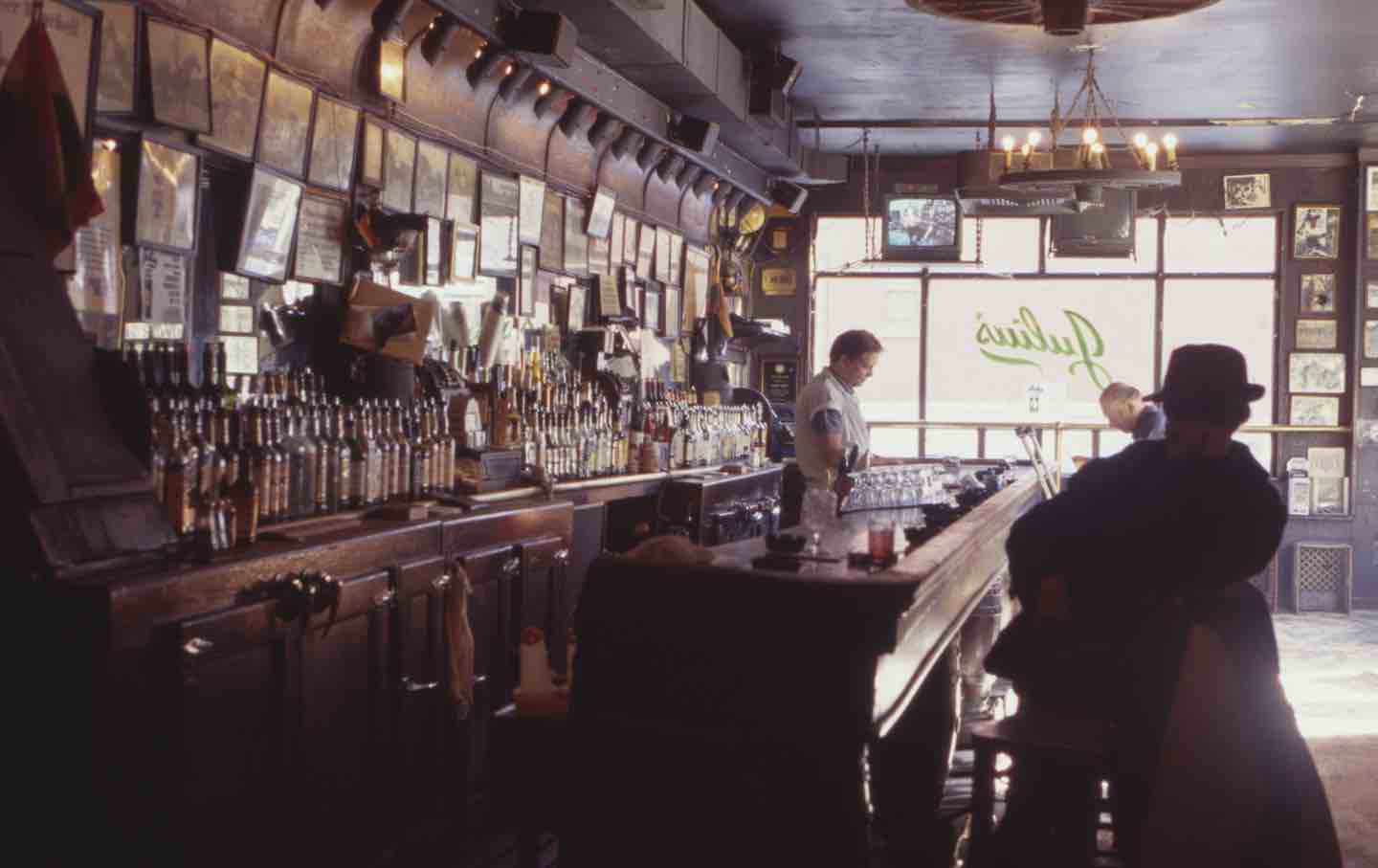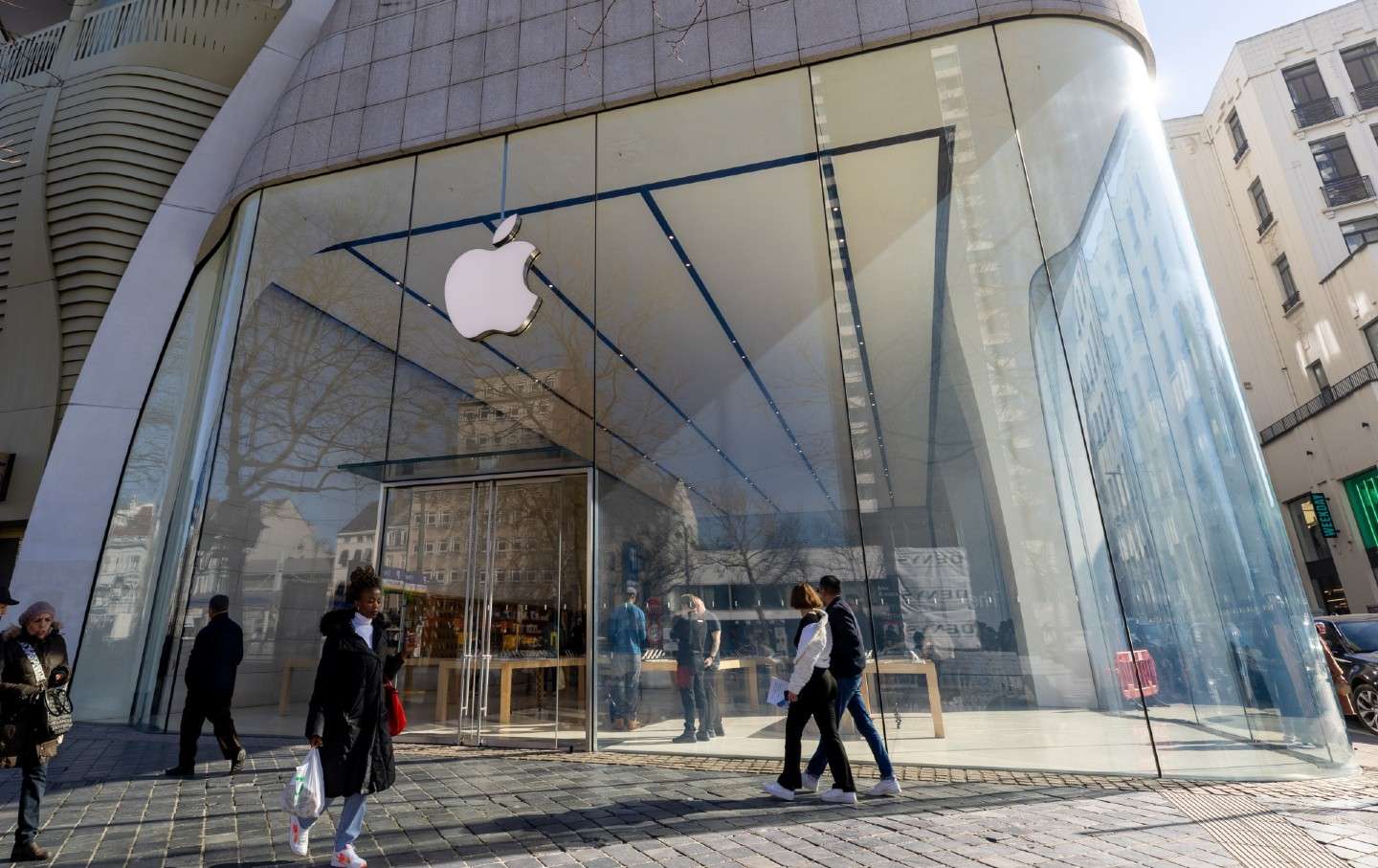The State of the Gay Bar
A new book explores the phenomenon of gay bar closures and the forms of nightlife that have emerged to replace them.

The interior of the bar Julius’ in Greenwich Village, New York City, circa 1990.
(Photo by David Lefranc / Gamma-Rapho via Getty Images)Queer nightlife is full of dreams, which at their best improve waking life. Coiled within conventional hopes for an evening is a utopian vision of society. “No one man owns house / because house music is a universal language,” Chuck Roberts announced on Mr. Fingers’s legendary 1988 single “Can You Feel It,” virtually a summation of the egalitarian intentions of not just dance music but the queer spaces that nurtured it too. Yet the LGBTQ+ scene also reflects the inequalities of the world at large. Rich, white, cis-gendered males in city centers usually have more access to queer bars and clubs, and when such spaces move to neighborhoods that are working-class, non-white, or on the urban outskirts, they’re often portents of gentrification. House’s idealism can become real when night falls, but only in exceptional environs. And these days, our reverence for queer establishments might direct the hetero mainstream to their doorsteps.
Books in review
Long Live Queer Nightlife: How the Closing of Gay Bars Sparked a Revolution
Buy this bookDuring the last decade, the legalization of same-sex marriage and an increasing acceptance of LGBTQ+ rights has led to a sentimental wave, generated partially outside of the queer community, in support of LGBTQ+ nightlife. There’s been an unprecedented flurry of media attention to longtime pillars, such as Julius’, the oldest gay bar in New York City, which the likes of The New York Times previously seldom covered. Since then, the Times has mentioned Julius’ on more than 20 occasions, including one article that followed mayoral candidate Kathryn Garcia as she greeted prospective voters outside the West Village watering hole. The change was so sudden it was bewildering to patrons, yet enabling for Julius’s future: Once a homey dive with older male regulars lining its stools, Julius’ managed to retain this core of its identity while simultaneously expanding into a present in which gays bars aren’t inherently hotbeds of lust or shelters for the excluded. On any given night, you’re likely to see gay men accompanied by friends of varied sexual orientations and gender identities and tourists crowding the bar, trawling through the recommendations they found on the Internet.
This comparative success story is facilitated by the large political shoes that the tavern feels obliged to fill: It was, after all, a site for one of the gay rights movement’s earliest protests. Adjustment came more easily than it did for most gay bars, which are suffering. According to data drawn from the long-running Damron Men’s Travel Guide, for a study published by the sociologist Greggor Mattson in the journal Socius, 36.6 percent of these businesses closed between 2007 and 2019 in the United States. But the causes of such closures are not crystal-clear.
Suspect number one, unsurprisingly, is the Internet and the rise of hook-up apps, which have ostensibly made gay bars less important for finding sex and romance. Yet the relevant data is scant—it’s difficult to collect—and this proposition could be countered with a similarly anecdotal argument that gay bars have gotten a second wind in much the same way Julius’ has. Other signs of life are rarely discussed: For example, LGBTQ+ bars in the United States decreased by 15.9 percent during the pandemic, but they rebounded 10 percent since their nadir in 2021, with lesbian bars and establishments that serve both men and women actually increasing in number since pre-Covid levels. Queerness worldwide is currently in the process of recentering itself away from gay maledom, and our ideas about what constitutes a queer bar are moving in tandem. The culture isn’t dying—it’s changing: While gay bars have shrunk in abundance domestically and abroad, queer nightlife’s imagination has only continued to grow.
What lingers is the warm promise heard in “Can You Feel It,” a belief in idealized futures. Gay bars may have fallen short on their potential for inclusivity, but the possibility itself hangs on, floating in the ether, waiting for a home that will do justice to its enduring spirit of optimism.
In his new book Long Live Queer Nightlife: How The Closing of Gays Bars Sparked a Revolution, Amin Ghaziani flips the script on doom-and-gloom narratives. There’s no reason, he argues, to despair about a resourceful culture that keeps learning fresh ways to survive. His ethnography uses the death of gay bars as its starting point, but not as the basis of its research. Long Live Queer Nightlife concentrates on an edgier movement of queer parties: ephemeral events that take over unused buildings or existing clubs and usually cater to a wider crowd than the cis-gendered white guys who, in the estimation of Ghaziani and many of the 112 people he interviews, are vastly overrepresented in more permanent gay establishments. Nomadic club nights are hardly a novel development; today, though, they’re mountingly popular in urban areas across the planet.
Ghaziani himself is a gay man—a Pakistan-born, American-raised professor at the University of British Columbia in Vancouver, who previously wrote a book about the decline of the American “gayborhood.” For Long Live Queer Nightlife, he leaves these traditional havens in the US behind for a more international milieu, a broad and roving swath of London’s queer nightlife. His respondents encompass Londoners of different races, gender identities, sexual orientations, and (to a lesser degree—his interview pool skews young) ages. Most impressively, he creates a context in which their voices can coexist for their difference, which he accomplishes not by slipping into professorial dryness but through his exuberance and his unwillingness to condescend to his subjects.
The book feels like a satellite image of London at night, with far-flung parties gleaming mostly on the edges, bright nodes in a darkened expanse. Ghaziani renders a complex picture of how going out as a queer person is changing; his approach to the topic, at once intimate and meticulous, ultimately enables his own perspective to shine through. Refreshingly, Long Live Queer Nightlife refuses anguish—Ghaziani’s jubilation at the emergence of the new outweighs his sorrow at the molting of the old.
He precedes every chapter with an evocation of a queer party, a lively and diverse entrée to the analysis that follows: The festivities include Buttmitzvah, a queer Jewish party at the Troxy concert hall; the CAMPerVAN, which involves a group that travels around England in a literal trailer, claiming a traditional British style of working-class vacation for queers who hail from that background; the Cocoa Butter Club, a POC performance troupe that stages a show at a pop-up festival; and Gayzpacho, which cheekily celebrates Spanish LGBTQ+ heritage through flamenco, wrestling in a pool full of tomatoes, and drag queens dressed like the Virgin Mary. In these sections both the author and his readers are made participants, voyeurs, and sociological students of what allows these parties to persist (low overheads, flexible financial outlays, and a rugged, undaunted desire to fill the holes in existing nighttime recreation). He tells us how much the entry to each venue cost, while also describing the emotions these evenings elicited. “We seized the joy of being melanated,” he muses about his night seeing the Cocoa Butter Club, “Something that, as I walked across Waterloo Bridge back home and then down memory lane later that night, I realized has not always served me well.”
Ghaziani fluidly weaves testimonies from interview subjects into his own narration, much of which involves how and why these folks have felt excluded from traditional gay bars—racism, femmephobia, dull commercialism, too many bad pop songs, and a general reorientation in this scene, thanks perhaps to its geographical centeredness and the changing economics of the inner city, toward serving the wealthy. At Buttmitzvah, he wonders if Jews feel offended by the party’s camp-ifying of everything from tefillin to bagels to the Exodus story. A friend reassures him: “It’s all about having fun! Not making fun!” Ghaziani navigates the system of codes that separates the playful from the offensive, shedding light on ways that people today own the intersections of their cultural experience. The book keeps the author himself in the shadows until about halfway through, when the narrative briefly focuses on his own life, a smart shift that also reinvigorates the text.
Ghaziani describes an afternoon at Roscoe’s, one of the gay anchors in Chicago’s Boystown neighborhood, back when he was a graduate student at Northwestern University in the 2000s. A white man approaches him at the bar, asks where he’s from (“I’m from here,” Ghaziani answers, confused), exoticizes his brown skin, and touches his arm without receiving any cues that physical contact is welcome. Ghaziani gets the man to buzz off, before he reflects, “After going to gay bars for the better part of my adult life, I have noticed that some people, like that guy in Chicago, seem intrigued when they see me; others, as best as I can tell, don’t even notice that I exist.” These dynamics are one reason the alternative of transitory queer parties seems hopeful, not like a Band-Aid on what he and others have termed the “closure epidemic” of gay bars. A fixed location once conferred legitimacy on queer functions, but this has changed in an era when rents everywhere are prohibitively expensive—many BIPOC, women, and gender-nonconforming people are excluded from urban queer life not just socially but also financially. Club nights offer them a chance to throw their own parties.
At the beginning of the next chapter, a new friend asks Ghaziani, “You’re South Asian and queer?” The question is jolting at first, but several days later this buddy whisks him off to Hungama, a celebration of South Asian queerness. The bash is located in a former warehouse, named for an Urdu word that loosely translates to “celebratory chaos”— projected Bollywood films adorn the walls and the DJs mix in Hindi tunes. Ghaziani finds ecstasy and acceptance here that feeds his text’s energetic, sanguine voice. The prose delights in the happy reality, however fleeting, of belonging in a group of people.
As Ghaziani writes, “Being an engaged citizen of the world, or a serious scholar, does not require us to evict joy from our mind or from our pen. I refuse to punctuate my book with pain.” He wants, in part, to fill the “joy deficit” among sociologists, but his intentions are more sweeping. He describes receiving a Hungama-related e-mail several years after he attended—an event invitation that he can’t accept because he’s back at home in Canada. While he reads the message, he recalls how “a collection of memories, from being bullied as an immigrant kid at school to feeling fetishized at that gay bar in Chicago because of my darker skin, rise to my awareness, booming like a bhangra beat.” He experiences his painful past at the same moment as he sees how a sunnier, insistent, pro-social future might surmount it. This same emotional kernel was at the root of gay liberation movements more than half a century ago.
Popular
“swipe left below to view more authors”Swipe →Why have gay bars closed? Ghaziani may neglect to make this well-trodden question the heart of his book, but he nonetheless offers a compelling answer. The sociologist interviews Ben Walters, a London-based writer and academic who focuses on endangered queer spaces. His commentary helps Ghaziani make a distinction between commercial viability and maximum profitability: “If the question is, are these places commercially viable, nine times out of ten the answer is yes,” Walters says. “If the question is, is this the maximum profit that can be wrung from this central London square footage, then the answer may be no—and that’s where the threat comes in.” Walters explains how landlords can usually squeeze more money from their properties in hugely valuable central London by building chain retail or eateries with housing above. There isn’t a lack of demand for gay bars—but the logic of corporate real estate means that they will never be able to compete with luxury condominium towers and cookie-cutter franchises in today’s extortionate metropolises. This problem, by no means reserved to London, informs the logic of landlords all over the earth.
Queer shindigs like the ones included in Long Live Queer Nightlife utilize “cracks” in this business ecosystem. They’re an instance of “crack Capitalism,” the title of a book by Marxist thinker John Holloway that describes how people find the rips in the prevalent economic fabric and exploit them, rather than feeling stultified by its apparent omnipotence. The impermanence of queer parties, for Ghaziani, can be a benefit: Is a building vacant for months as a landlord tries to find a tenant willing to pay $17,000 a month in rent? Someone might throw a wild, fun DJ set replete with video projections, a sprawling dance floor, and maybe even a separate art installation. This itinerant model not only affords organizers more fiscal freedom but is feasible for other reasons, too—according to one study, queers are 73 percent more likely to be turned down for a bank loan than heterosexuals, and they encounter higher interest rates and fees when they are approved.
Ghaziani’s invocation of “crack Capitalism” is thought-provoking, but it raises a number of questions: What does a shift from gay bars to one-off parties mean for bartenders, waiters, barbacks, bathroom attendants, and security personnel? Are their livelihoods less secure? And does capitalizing on these cracks, and selling them back to a new generation of queer youth, ultimately fuel the status quo by making the young believe that they have opportunities to thrive within the nooks and crannies of an edifice they might otherwise try and dismantle?
The reality of club nights, though, is that they generally don’t prosper. At least not according to ordinary metrics: The logistics are too tenuous, the profit margins low or nonexistent. What these venues offer are buds of prospective queer lifestyles that occasionally blossom in nutrient-starved soil. The surrounding climate is harsh—this has been clear for decades. But who hasn’t marveled at a lone flower, during the brief span when it’s in bloom?
Hold the powerful to account by supporting The Nation
The chaos and cruelty of the Trump administration reaches new lows each week.
Trump’s catastrophic “Liberation Day” has wreaked havoc on the world economy and set up yet another constitutional crisis at home. Plainclothes officers continue to abduct university students off the streets. So-called “enemy aliens” are flown abroad to a mega prison against the orders of the courts. And Signalgate promises to be the first of many incompetence scandals that expose the brutal violence at the core of the American empire.
At a time when elite universities, powerful law firms, and influential media outlets are capitulating to Trump’s intimidation, The Nation is more determined than ever before to hold the powerful to account.
In just the last month, we’ve published reporting on how Trump outsources his mass deportation agenda to other countries, exposed the administration’s appeal to obscure laws to carry out its repressive agenda, and amplified the voices of brave student activists targeted by universities.
We also continue to tell the stories of those who fight back against Trump and Musk, whether on the streets in growing protest movements, in town halls across the country, or in critical state elections—like Wisconsin’s recent state Supreme Court race—that provide a model for resisting Trumpism and prove that Musk can’t buy our democracy.
This is the journalism that matters in 2025. But we can’t do this without you. As a reader-supported publication, we rely on the support of generous donors. Please, help make our essential independent journalism possible with a donation today.
In solidarity,
The Editors
The Nation








